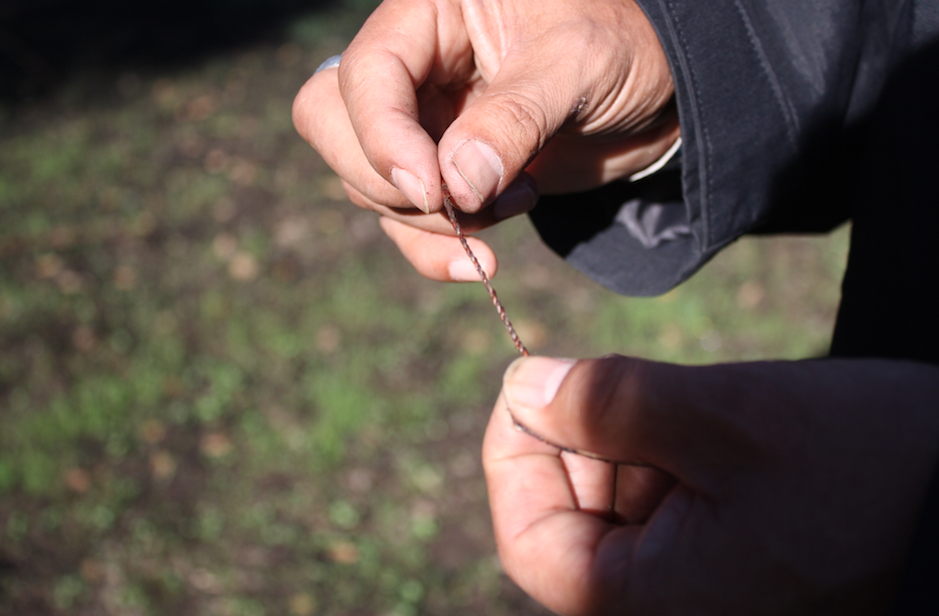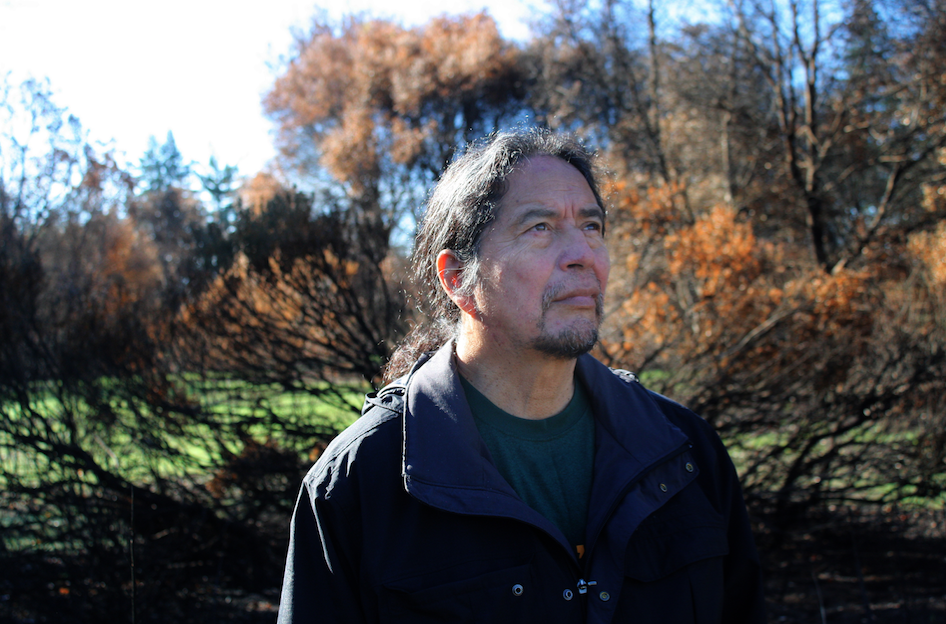Lessons from a Fire Ecology
By Leilani Clark
A few times a year, Edward Willie tends to the last remaining dogbane patch in Sonoma County.
Situated on a three-acre preserve bordering Highway 101 in northern Santa Rosa, the patch is estimated to be centuries old and once spanned a five-mile radius. Neighboring tribes—mainly Pomo and Wapo—cultivated the fibrous, stalky native plants to make cordage for hunting and fishing nets and other tools.
The Tubbs Fire burned hot and fast through the preserve, on its way to hopping the six-lane highway, leaving behind a scorched landscape of Himalayan blackberry roots and the black skeletons of wild plum trees and coyote bush. Yet, for the most part, the dogbane survived. In some formerly vegetation-choked areas of the preserve, the spindly plants are all that remain.
“The dogbane needs fire—that’s what makes it grow tall and strong,” says Willie, a native Pomo, Walaeki, and Wintu teacher and core organizer of the Buckeye Gathering, an annual nature-based paleo-technology meeting in Northern California. Researchers have found that dogbane sprouts quickly after fire and can become more abundant. Burning actually stimulates new, straight growth.

Leilani Clark
Less than a mile away from the preserve, block after block of ruined homes, businesses, and cars stand as a reminder of the conflagration that wreaked havoc across three Northern California counties in the early morning hours of October 9. Despite the scope of the tragedy, Willie sees regeneration and even radical hope in the region’s fire ecology.
“It’s a happy [dogbane] patch now,” he says, as he demonstrates how to peel the taut fibers from the plant’s stalk. “It’s filled with life. New sprouts are already coming up. It’s a California plant, a fire plant. It was made to survive this.”
For people like Edward Willie and Erik Ohlsen, an ecological designer and director of th Permaculture Skills Center in Sebastopol, the North Bay fires were a wake-up call, a chance proactively address the way the plants and animals of Northern California, and most of the Golden State, have co-evolved with fire— and to rebuild these communities with fire in mind.
Others go further, saying that poor planning and land management practices turned a natural feature of chaparral landscapes into a catastrophic force, leaving in its wake $9 billion in estimated damages.
Fight Fire with Fire
At a “Fire Resilient Landscapes and Management” panel at the Sebastopol Grange in early November, Ohlsen told a group of farmers, land managers, and slow-food advocates that it was time for Californians to reckon with the relationship between humans, land, and fire. “It seems that as a culture we’ve forgotten what it’s like to live in a fire ecology,” he said. “How can we avoid having such destructive wake-up calls?”
His assertion is shared by Dr. Sasha Berleman, a fire ecologist with Audubon Canyon Ranch (ACR), an environmental conservation and education organization headquartered at Bouverie Preserve in Glen Ellen. “All of our plant communities depend on fire as part of their life cycle,” says Berleman. “Many of them depend on fire that occurs more frequently than we’ve allowed it to burn.”
Native Americans knew this, Berleman says, and used fire to manage landscapes for food and textile production. As David Carle writes in Introduction to Fire in California, indigenous California tribes set fire to the landscape to reduce the threat of wildfires to their villages, to stimulate the re-sprouting of the straight stems needed for basketry and tools, to control insects, fungus and pathogens, and to stimulate the growth of seeds.
Berleman was in the early stages of launching a fire ecology program at ACR when the Nuns Fire swept through the Bouverie Preserve, destroying 80 percent of the structures. A trained wildland firefighter, Berleman spent hours successfully defending architect David Bouverie’s former home along with the “Last House,” where famed cookbook author M.F.K. Fisher spent her final years. Last May, Berleman conducted a few initial small, prescribed burns to reduce the fuel load on grasslands on the preserve. An early, informal assessment showed that these areas burned less intensely than other parts, and helped moderate the fire’s progression.
“Fire can’t be prevented, it can only be postponed,” says Berleman. She advocates for two solutions to future fire threats. First, an “all hands on deck” cooperative approach to fuels treatments on private and public land: prescribed fire, broadcast burning, mechanical thinning, and grazing. Second, improved public education on the integral role of fire in California ecosystems. Recently, the state provided her funding to establish a highly trained, interagency fire crew to implement technically approved prescribed fuels treatments and controlled burns on private land in Sonoma County starting this fall.
“We have a chance to reactivate our stewardship role,” she says. Now, she just needs to get fire-averse landowners and a smoke-wary public on board.
Grazing: Land Management’s Missing Link?

Leilani Clark
Marie Hoff, a sheep owner and grazer in Mendocino County, says that grazing is the missing link in managing rangelands for fire safety. For centuries, the California landscape was populated by large grazing animals like deer and elk, but those populations have severely declined with human settlement.
“If you don’t graze, it creates tinder,” says Hoff. Hoff shepherds 20 Ouessant sheep, a primitive breed from France with a preference for dry, brushy environments. Hoff’s grazing operation has two distinct functions. Summer through fall, the sheep reduce fuel loads on hilly open rangeland in Sonoma County. Come October and rain, they transition into weed abatement on agricultural land: vineyards, orchards, and farms. In the spring, Hoff breeds the sheep and processes their fleece into yarn.
Hoff is working to bring together stakeholders like University of California Cooperative Extension to position agrarians as a solution to managing for a fire ecology on public lands, open spaces, and regional parks. Her small flock, while not big enough to address the scope of need, will provide a model for projects in Mendocino and Sonoma counties, followed by larger scale grazing contracts based on mapping for high fire-prone areas.
“I’d like to get some of that off the ground this year, which will hopefully lead to state funding for contract grazing,” says Hoff. “The fire season, and all that comes with it, is going to be more and more of an issue in the future. We need to manage our landscape.”
Did Poor Planning Increase the Fire’s Devastation?
Fuels treatment, or a lack thereof, isn’t the only factor that’s been blamed for the wildfires’ catastrophic impacts. Gaye LeBaron, longtime Press Democrat columnist, wrote in the Washington Post about how Santa Rosa ignored nature’s warning by developing thousands of homes within the same footprint as the infamous Hanly Fire of 1964. The difference, wrote LeBaron, is that back then, “there were very few houses in the area that burned. As the city limits extended and the population increased by 135,000, the open land in that earlier fire corridor became a destination for developers.”
“Bigger homes, closer together is a recipe for more fuel on the landscape,” says Dr. Gregory L. Simon, an associate professor of Geography and environmental sciences at the University of Colorado and author of Flame and Fortune in the American West. “In my opinion, we shouldn’t be building homes in areas of high fire risk at all. It’s not a matter of building fire-safe construction or zoning in certain ways. Simply because of the loss of life involved and the risk to first responders.”
At the same time, Simon doesn’t foresee any reduction in the demand for new homes in the Bay Area, fire risk or not. What’s more, developed land is worth much more than undeveloped land, whether to developers, who can subdivide it, or to city and county governments that benefit from property taxes. So what can be done?
From extensive study of the Oakland/Berkeley Fire of 1991, Simon says homes rebuilt in fire risk zones should be constructed according to the most stringent standards with the municipal infrastructure to handle wildfire events. Water pipes should be able to accommodate the large amounts of water needed to fight a fire. Roads must be wide enough to accommodate fire trucks. And aboveground, exposed power lines, which carry a host of hazards, from explosion to blocking roadways, should be moved underground.
“If we understand that an area has a fire risk, but, for whatever reason, the city wanted to develop that area, the least they should do is make sure that the municipal infrastructure components are fire compatible,” says Simon. He will be speaking more on the topic at Copperfield’s Books in Montgomery Village on March 10 at 7pm.
Fire ecologist Sasha Berleman says this is a crucial time for Californians to acknowledge the role of fire in the state’s ecology, wherever their home is located. Maybe it’s time to learn from the dogbane.
“We have an opportunity to change what happens next time,” says Berleman. “We live in a fire-adapted landscape, and we need to make ourselves a fire-adapted people.”
This story originally ran in Civil Eats and was reprinted with permission.
